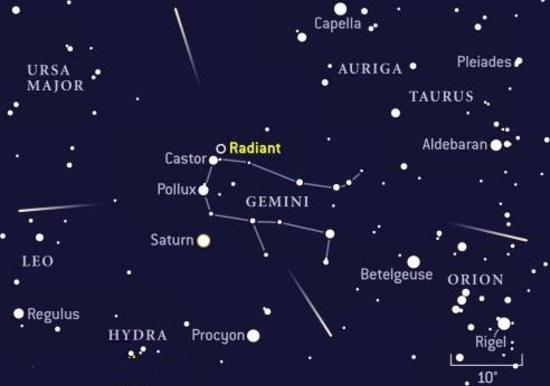For those of you who have never seen a meteor shower, it’s really beautiful.
It’s that time of year: the annual Geminid Meteor Shower, and astronomers are saying it’s a "great year" to view it. This is because, unlike last year, the moon will be in crescent phase (rather than a full moon), making the night sky darker and the meteors easier to see.
Under normal conditions on the night of maximum activity, with ideal dark-sky conditions, at least 60 to 120 Geminid meteors can be expected to burst across the sky every hour on the average, on the peak night.
The Geminid Meteor Shower is very popular, because the meteors last longer in the sky (travelling half as fast as other meteors in other showers) making them easier to catch. Once you’ve seen a few, and at peak times, it kind of looks like field mice scurrying across the night sky.
Although you can probably see the shower any night this week (if you know where and when to look), the peak night is December 13-14.
If you’re lucky, you might even catch an "earth grazer", which is quite different from a typical streak-across-the-sky meteor. Earthgrazers are much larger and slower, having entered the earth’s atmosphere. It’s a slow-moving ball of fire. It often gets mistaken for a UFO. Here’s what one looks like:
Earthgrazers are usually low in the horizon. But pretty rare.
So how do you know where and when to look? Well, the meteors eminate from the Gemini constellation. Gemini will start to come above the horizon — in the east-to-northeast — at twilight. You might be able to catch a few meteors even that early.
Gemini should be easy to find, if you can find Orion’s belt. Take a look at this picture below to see where Castor and Pollux are in relation to Orion’s belt (Try to envision this picture without the labels and lines). Generally, you will find this in the eastern sky (lower in the eastern sky if you are going out earlier; higher if you are going out later).
(Just a note — I think Mars — not depicted in the map — will be in there somewhere, so don’t let it throw you. You can tell Mars by its reddish tint).
10 pm will be a decent viewing time, and 2 am is probably optimal, since Gemini will be almost directly overhead and the radiant path of the meteors will be visible. Unfortunately, the moon will be rising starting at about 1:30 am, so that tends to make them harder to see.
The meteors will appear to emanate from the star Castor in the Gemini constellation, but here’s the thing — you probably won’t see them if you look right at Castor. After sunset, you should face generally east and look halfway up. You won’t need binoculars or a telescope (in fact, those devices limit your field of vision — you often "catch" meteors out of the corner of your eye). Obviously, the further you are from ambient light (from the city), the better.
Happy skywatching!


